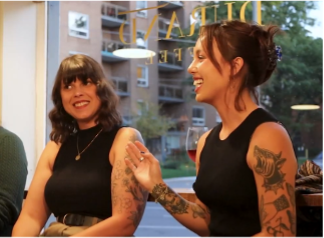Shadows of Nothingness: Art Exhibition and Conversation
- Pedagogies of Hope Collective

- Apr 8
- 3 min read

In the fall of 2024, the Shadows of Nothingness art exhibit, located at Durand Coffee in Hamilton, Ontario, showcased a selection of pieces working around queer silence and nothingness. Through printmaking and embossing techniques, Shadows of Nothingness invites viewers to engage in the ongoing creative and scholarly work of queer Iranian artist, activist, and feminist educator, Aytak Dibavar as they navigate the “delicate interplay between presence and absence…the elusive nature of nothingness, shadows, and the traces left behind”.
On its opening night, guests were invited to attend a panelist conversation on archives, silence, and erasures as part of the opening reception. In conversation with Stephanie Rico, Cassidy Burr, and Maddi Chan, the panel of Pedagogies of Hope members reflected on the complexities, processes, and ethics of archival absence and practice.

The evening began with the following introduction from Aytak:
In my work, I move through Islamic Sufism and a decolonial feminist reading of quantum physics to queer our understanding of concepts such as silence, absence, and nothingness. In many ways, what has historically been deemed “nothing” (nothing important, nothing relevant, nothing significant) has either been erased, violated, or colonized. We can cull examples like terra nullius, the lands deemed empty and void by a European audience, thereby justifying their colonization. The people to whom these lands belonged were equally considered devoid of “meaning or value,” and therefore the massacre, displacement, and enslavement of those whose bodies, lives, and lifestyles were justified. Or we can consider the coloniality of knowledge. Bodies of knowledge produced outside of the colonial world have been historically treated as lesser than, offering no significant contribution, and therefore either erased or ignored. And, finally, we can think of the absences and the void that has been (and continues to be) created due to the violent process of colonial and imperial erasure.
So, the question that I seek to answer is how can nothingness and void be reworked into a historical archive—one we cannot avoid, turn a blind eye to, or ignore?
I have always been fascinated with silence, the unknown, the untranslatable, the things that can’t be worded, the un worded things – the nothing.
What lies beyond the boundary of knowability, beyond the limit of our senses, sound, sight, touch, taste, vibration – the feltness of the unknown – where ‘nothing’ begins.
We either ignore nothing, a-void it, assume its emptiness – rush to fill it, know it, master it, rush to fight against the fear of its unknowability.
In many ways the constructions of nothingness and absence exist in complex and intimate relationships with longer histories of cis-heteropatriarchy, capitalism, settler/colonialism, and imperialism.
What spills out of the apparatus or refuses to be captured within its defined boundaries, remains invisible and inaudible; absent figures, silent voices and all that tends to constitute nothingness or that gets set aside as unimportant. Yet, what appears to be ‘nothingness,’ that which is left out of the sensible – at the level of the political in all its inconsistencies and indeterminacies that challenge assumptions – does have a an identifiable ‘somethingness.’ A ‘somethingness’ that is apparent in the shape of its absence.
The shape of an absence. The shape of an erasure: annihilated maps, cities, people, histories, memories. Reduced to nothing.
Nothingness’ exists, it is present. it leaves traces, event attempting to erase traces leaves traces…
My artwork troubles the notion of boundaries, erasures and clear cuts, it invites us to sit with the discomfort of the unknown and remain present with its absence.

















Comments